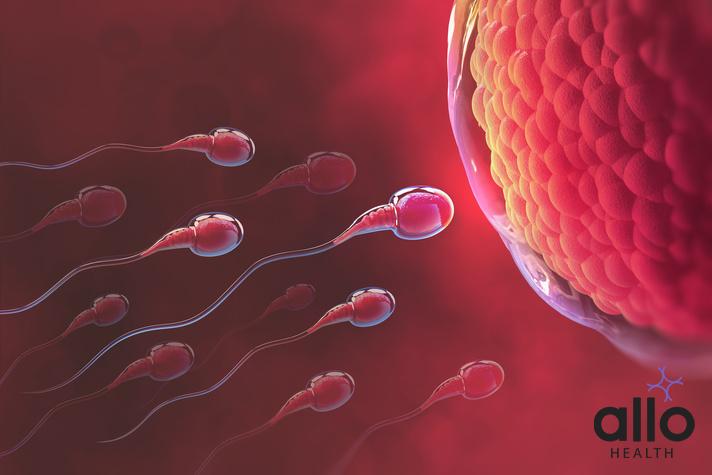Female Sperm? Let’s Clear Things Up!

Allo Health is dedicated to personalized well-being, offering support and trusted information tailored to individual health goals. The platform emphasizes human-generated content, led by a distinguished medical team of experts, including physicians and sexual health specialists. Their commitment to credibility involves rigorous fact-checking, authoritative research, and continuous updates to ensure accurate, up-to-date information. Allo Health's unique approach goes beyond conventional platforms, providing expert-led insights and a continuous commitment to excellence, with user feedback playing a crucial role in shaping the platform's authoritative voice.

Dr. Aditi completed her undergraduate medical education at AJIMS, Mangalore, after which she worked in multi-speciality hospitals with COVID patients and in the Pain and Palliative medicine department. Driven by her experiences, she developed a keen interest in psychiatry. Dr. Aditi believes that mental health is just as, if not more important, than physical health.
Why This Was Upated?
Our experts continually monitor the health and wellness space, and we update our articles when new information became available.
Updated on 19 December, 2023
- Article was updated as part of our commitment to diversity, equity, and inclusion.

"The following blog article provides general information and insights on various topics. However, it is important to note that the information presented is not intended as professional advice in any specific field or area. The content of this blog is for general educational and informational purposes only.
Book consultation
The content should not be interpreted as endorsement, recommendation, or guarantee of any product, service, or information mentioned. Readers are solely responsible for the decisions and actions they take based on the information provided in this blog. It is essential to exercise individual judgment, critical thinking, and personal responsibility when applying or implementing any information or suggestions discussed in the blog."
One of the first things that come to mind when we think about reproduction is sperm. We often hear of male sperm, but what about female sperm? Is there such a thing?
What Is Female Sperm Called?
Sperm are reproductive cells produced by males and contain either an X or a Y chromosome, which determines the sex of the offspring. Sperm carrying an X chromosome combine with an egg (which always carries an X chromosome) to form a female offspring (XX), while sperm carrying a Y chromosome combine with an egg to form a male offspring (XY).
But if you’re wondering what female sperm is known as, we’d like to encourage you to understand that the concept of “female sperm” is not accurate. Sperm are produced by male reproductive systems and carry genetic material that determines the sex of the resulting offspring when combined with an egg. There is no distinction between “male sperm” and “female sperm” beyond the presence of X or Y chromosomes, which determines the sex of the potential offspring.
The Science Behind “Female Sperm”
Sperm cells produced by males inherently carry either an X or a Y chromosome, which determines the sex of the offspring when combined with an egg.
There has been some research and discussion about technologies like sperm sorting and sex selection for assisted reproduction purposes. These methods do not involve changing the genetic content of the sperm but rather separating sperm with X chromosomes (which can result in female offspring) from sperm with Y chromosomes (which can result in male offspring). Techniques like flow cytometry have been used for this purpose, but the methods are not 100% accurate and have ethical considerations.
It’s important to note that scientific understanding and technology can evolve, so there might have been developments in this area after September 2021. If you’re looking for the most up-to-date and accurate information, I recommend consulting recent scientific literature or reputable sources in the field of reproductive biology.
What Is Sperm?
Sperm, also known as spermatozoa, are specialized male reproductive cells essential for sexual reproduction in many animals, including humans. Sperm cells are responsible for delivering the genetic material from the father to the mother’s egg, leading to the formation of a new individual.
Here’s a detailed overview of sperm:
Structure
Sperm cells are tiny and highly specialized. They consist of several distinct parts:
- Head: The head contains the genetic material of the sperm, consisting of a nucleus with 23 chromosomes. These chromosomes carry the genetic information that will determine the characteristics of the offspring.
- Acrosome: This is a cap-like structure covering the head of the sperm. It contains enzymes that help the sperm penetrate the protective layers of the egg during fertilization.
- Midpiece: The midpiece contains mitochondria, which are the energy-producing structures of the cell. These mitochondria provide the energy needed for the sperm to swim and move towards the egg.
- Tail (Flagellum): The tail is a long, whip-like structure that propels the sperm forward. It contains microtubules that create a whip-like motion, allowing the sperm to swim through the female reproductive tract.
Production and Maturation
Sperm cells are produced in the testes through a process called spermatogenesis. This process involves multiple stages of cell division and differentiation. Immature sperm cells undergo a series of transformations as they move from the innermost layers of the seminiferous tubules in the testes to the lumen (center). As they mature, they develop the distinct structures needed for fertilization.
Function
The primary function of sperm is to deliver the father’s genetic material to the mother’s egg during fertilization. When a sperm cell successfully reaches an egg cell, it releases enzymes from its acrosome, which help it penetrate the outer layers of the egg. Once the sperm penetrates the egg, their genetic material combines, resulting in a zygote—a fertilized egg that will develop into a new individual.
Production Rate
The production of sperm is a continuous process in healthy adult males. It’s estimated that millions of sperm cells are produced daily. Not all sperm cells are viable, and only a small fraction of them will successfully reach and fertilize an egg.
Lifespan and Viability
Sperm cells have a relatively short lifespan outside the male reproductive tract. In optimal conditions, they can survive for a few days. Their viability decreases significantly over time, and they require the moist environment of the female reproductive tract to remain viable for fertilization.
What Are Sperm Cells?
Sperm cells are gametes, which are reproductive cells that fuse with another gamete (the egg) during fertilization to create a new individual. Each sperm cell is haploid, meaning it contains half the usual number of chromosomes found in other body cells. In humans, the typical chromosome count is 46, but sperm cells and egg cells each contain 23 chromosomes.
Sperm cells are divided into two categories based on the type of sex chromosome they carry:
- Sperm with an X chromosome: These sperm cells carry genetic information that can result in female offspring when combined with an egg.
- Sperm with a Y chromosome: These sperm cells carry genetic information that can result in male offspring when combined with an egg.
During fertilization, a sperm cell fuses with an egg cell (which always carries an X chromosome) to create a zygote with the full complement of 46 chromosomes, from which the individual’s traits and characteristics are determined.
The terms “male sperm” and “female sperm” are not scientifically accurate, as all sperm cells are produced by males and have inherent characteristics based on the presence of X or Y chromosomes. If there have been any developments in our understanding of this topic beyond September 2021, I recommend referring to more recent scientific literature or consulting experts in the field of reproductive biology.
What Are Sex Hormones?
Sex hormones are a group of specialized chemical messengers produced by the endocrine glands that regulate the development and function of reproductive systems and secondary sexual characteristics in organisms with sexual reproduction. In mammals, including humans, these hormones play a fundamental role in sexual differentiation, development, and the maintenance of reproductive health. There are several types of sex hormones, each with distinct functions:
- Testosterone: Testosterone is the primary male sex hormone, though it’s present in both males and females. It’s mainly produced by the testes in males and the ovaries and adrenal glands in females. In males, testosterone is responsible for the development of male reproductive organs, sperm production, and the emergence of secondary sexual characteristics like facial hair, deep voice, and increased muscle mass. It also contributes to male libido (sex drive).
- Estrogens: Estrogens are a group of hormones that includes estradiol, estrone, and estriol. They are primarily produced by the ovaries in females and to a lesser extent by the testes in males and the adrenal glands. Estrogens are crucial for the development and maintenance of female reproductive organs, such as the uterus, ovaries, and breasts. They also play a role in the menstrual cycle, bone health, and the development of secondary sexual characteristics in females, such as breast development and a higher-pitched voice.
- Progesterone: Progesterone is primarily produced by the ovaries after ovulation and plays a critical role in preparing the uterus for pregnancy. It helps maintain the uterine lining, which is necessary for embryo implantation. If pregnancy occurs, the placenta takes over the production of progesterone to support the pregnancy. Progesterone also has effects on the female reproductive system, including influencing the menstrual cycle.
- Follicle-Stimulating Hormone (FSH) and Luteinizing Hormone (LH): These hormones are produced by the anterior pituitary gland in the brain. In males, FSH stimulates the production of sperm in the testes, while LH triggers the production of testosterone. In females, FSH and LH regulate the menstrual cycle and ovulation. LH surge triggers ovulation and is necessary for the formation of the corpus luteum, which produces progesterone.
- Gonadotropin-Releasing Hormone (GnRH): GnRH is produced by the hypothalamus in the brain and stimulates the release of FSH and LH from the pituitary gland. It plays a central role in the regulation of reproductive hormone production.
These sex hormones work in a complex and interconnected manner to orchestrate the development, maturation, and functioning of the reproductive systems in both males and females. They also have broader effects on various body systems, including bone health, metabolism, and mood. Imbalances in sex hormones can lead to various reproductive disorders and health concerns.

The Myths and Misconceptions Surrounding Female Sperm
Certainly, there have been myths and misconceptions surrounding the concept of “female sperm.” Here are some of the common myths and the corresponding scientific clarifications:
- Myth: Female Sperm Exists: Some misconceptions suggest that there are distinct types of sperm cells that can be categorized as “female sperm” and “male sperm.” In reality, all sperm cells are produced by males and carry either an X or a Y chromosome, determining the sex of the potential offspring.
- Myth: Controlling the Sex of Offspring: Some people believe that certain techniques or methods can guarantee the birth of a child of a specific sex. While methods like sperm sorting and sex selection exist, they are not infallible and are often used for assisted reproductive purposes, such as in vitro fertilization (IVF). These methods do not involve altering the fundamental nature of sperm cells but rather sorting them based on their sex chromosomes.
- Myth: Changing Sperm’s Chromosomes: There is a misconception that it’s possible to change the sex chromosome carried by a sperm cell. As of my last update in September 2021, there is no scientifically proven method to alter the sex chromosome composition of sperm cells. The sex chromosomes in sperm cells are determined during meiosis, a process that occurs naturally within the male reproductive system.
- Myth: Different Characteristics of “Female Sperm”: Some myths suggest that “female sperm” might have different characteristics or behaviors compared to “male sperm.” In reality, sperm cells do not possess gender-specific traits or behaviors; they are specialized cells designed for the purpose of fertilization.
- Myth: Dietary or Lifestyle Changes for Gender Selection: There are unproven claims that changing one’s diet or lifestyle can influence the sex of the offspring. The sex of an offspring is determined by the combination of genetic material from both parents, and there is no conclusive scientific evidence that specific diets or behaviors can consistently influence the sex of the child.
Frequently Asked Questions
(1) What is Female Sperm Called?
There is no scientific concept of “female sperm.” Sperm cells are produced by males and contain either an X or a Y chromosome, determining the sex of the offspring. Sperm carrying an X chromosome can result in female offspring (XX), while those with a Y chromosome can lead to male offspring (XY).
(2) Can Sperm Gender be Controlled?
While some techniques like sperm sorting and sex selection exist, they aren’t foolproof. These methods are used in assisted reproduction like IVF to separate X and Y chromosome-bearing sperm. Controlling offspring’s gender isn’t guaranteed due to various factors influencing conception.
(3) Can You Change Sperm’s Chromosomes?
Currently, science doesn’t provide a way to alter sperm’s inherent genetic content. Sex chromosomes are determined during meiosis, a natural process. No method has been proven to intentionally change the sex chromosomes in sperm cells.
(4) Are There Different Traits in “Female Sperm”?
There’s no differentiation between “female” and “male” sperm beyond their sex chromosomes. All sperm cells serve the same function: fertilizing an egg. Claims of different characteristics are not scientifically supported.
(5) Do Lifestyle Changes Affect Sperm Gender?
Claims that diet or lifestyle changes can consistently influence offspring’s gender lack strong scientific backing. Offspring’s sex is determined by genetic material from both parents. While maintaining a healthy lifestyle is important, it’s unlikely to guarantee a specific gender outcome.
(6) Is There a Type of Sperm for Girls?
No, all sperm cells are the same in structure and function. Sperm carrying an X chromosome can result in female offspring, but the idea of a separate “type” of sperm for girls is not scientifically accurate.
(7) Can a Certain Position Influence Sperm Gender?
Claims that sexual positions can influence the gender of the offspring lack scientific evidence. Sperm travel towards the egg regardless of position. Gender determination occurs at fertilization.
(8) Can Supplements or Foods Change Sperm Gender?
Claims that specific supplements or foods can alter sperm gender are not well-supported by science. While a balanced diet and healthy lifestyle are important, no magic food can reliably influence the sex of offspring.
(9) Do Certain Times of Conception Lead to Girls?
Timing of conception doesn’t consistently determine offspring gender. Sperm longevity and egg viability play roles in fertilization. Offspring’s gender is determined by the genetic combination of sperm and egg.
(10) Are There Medical Procedures for “Female Sperm”?
Medical procedures like IVF with sex selection exist, but they involve separating sperm based on X and Y chromosomes, not creating “female sperm.” The procedures are complex, and ethical considerations apply.






































